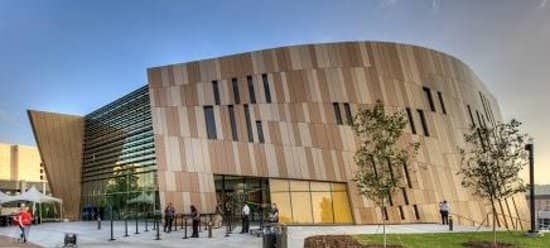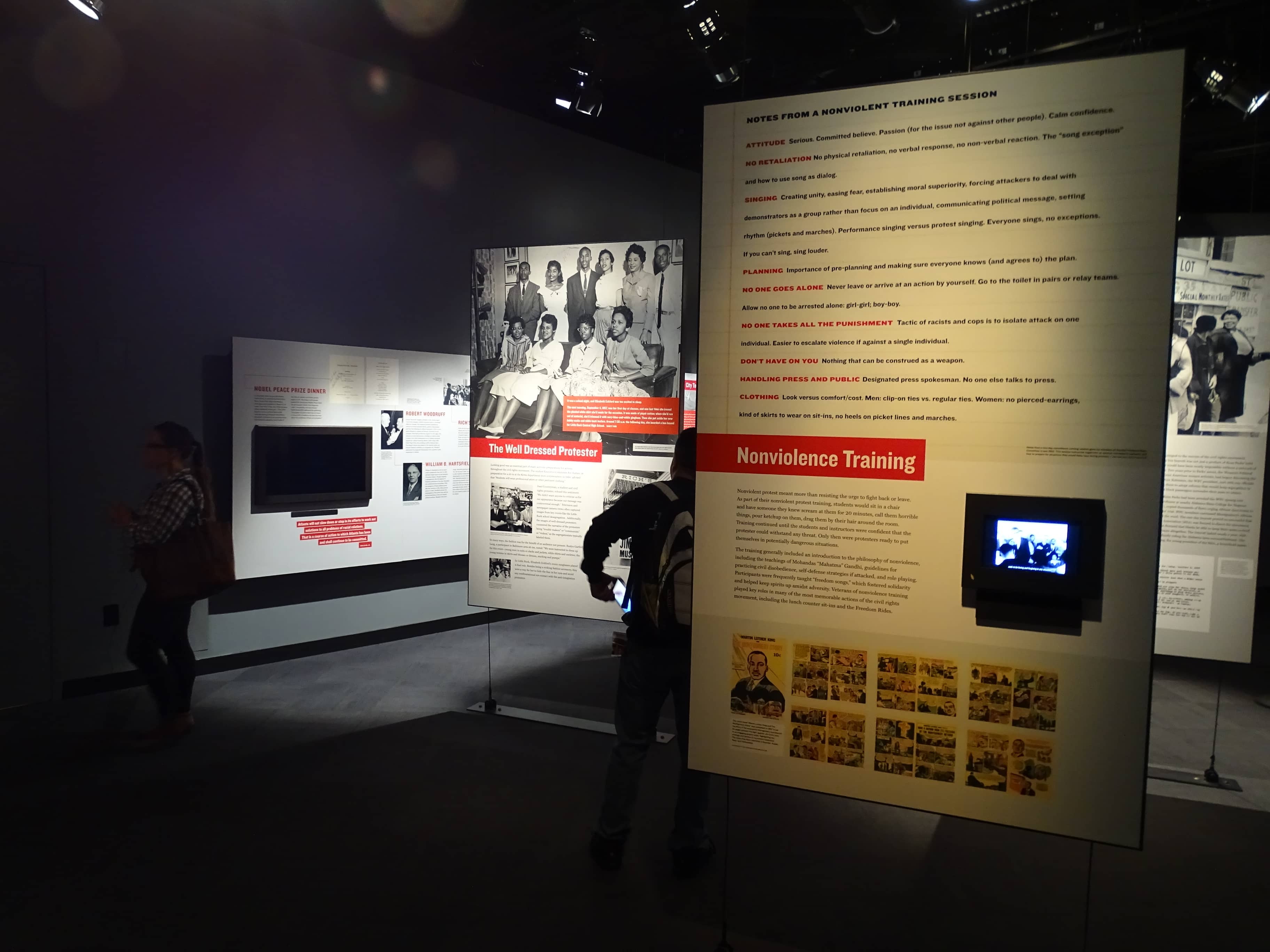
National Center for Civil and Human Rights
An impactful museum exploring the struggles and triumphs of the Civil Rights Movement and global human rights.

Highlights
Must-see attractions

Social
From TikTok & Reddit
Best Time
Fewer crowds, more reflection time

National Center for Civil and Human Rights
Best Time
Fewer crowds, more reflection time

Highlights
Must-see attractions
An impactful museum exploring the struggles and triumphs of the Civil Rights Movement and global human rights.
"One of the highlights of our visit to Atlanta; we walked away more informed."

Allocate ample time
Plan for 1.5-2 hours to truly absorb the impactful exhibits.
Prepare for emotions
Bring tissues; many exhibits are deeply moving.

Highlights
Discover the most iconic attractions and experiences

Lunch Counter Sit-In Simulation
Civil Rights Movement Exhibit
Experience a pivotal moment of the Civil Rights Era through an immersive simulation that challenges your perspective.

March on Washington Immersion
Civil Rights Movement Exhibit
Feel the energy of Dr. King's 'I Have a Dream' speech and the historic March on Washington.

Global Human Rights Gallery
Human Rights Exhibit
Explore contemporary human rights issues worldwide and understand your role in global justice.

Lorraine Motel Balcony Replica
Civil Rights Movement Exhibit
A somber yet crucial exhibit reflecting on Dr. Martin Luther King Jr.'s assassination.
Plans like a pro.
Thinks like you
Planning Your Visit
Plan for Impact
Temporary Closure Alert
Best Times
Insider Tips
from TikTok, Instagram & Reddit
Allocate ample time
Plan for 1.5-2 hours to truly absorb the impactful exhibits.
Prepare for emotions
Bring tissues; many exhibits are deeply moving.
Check for events
The museum hosts special events, especially during Black History Month.
Wear comfortable shoes
You'll be on your feet exploring powerful stories.
Tips
from all over the internet
Allocate ample time
Plan for 1.5-2 hours to truly absorb the impactful exhibits.
Prepare for emotions
Bring tissues; many exhibits are deeply moving.
Check for events
The museum hosts special events, especially during Black History Month.
Wear comfortable shoes
You'll be on your feet exploring powerful stories.
Engage with staff
Museum staff are welcoming and can offer insights.
What Travellers Say
Reviews Summary
Visitors consistently praise the National Center for Civil and Human Rights as a deeply impactful and educational experience, highlighting its immersive exhibits and powerful storytelling. While some find the emotional weight challenging, most agree it's a must-visit for its thought-provoking content and relevance to contemporary issues. The museum's ability to connect historical struggles to global human rights is particularly lauded.
"A MUST for any and everyone visiting the ATL! The National Center for Civil and Human Rights is temporarily closed for renovation until Fall 2025, we can’t wait to see what’s in store!! Until then here is an array of photographs from our last visit."
Lincoln Cochran
"We came here using the Atlanta City Pass and this was one of the optional choices. It's a pretty small museum in terms of its size, but it is very impactful. There are a lot of educational exhibits about the history of civil rights in the United States, with a large focus on Dr. Martin Luther King Jr. as well as many martyrs and victims. It moved me greatly to see the struggles that people went through, and still go through. Tissue boxes can be found around some of the more emotional exhibits, which I thought was very thoughtful. This was a beautiful place that provoked a great deal of reflection for me and my party. The gift shop has some lovely items. We spent about an hour and a half here. Every person who was working was very pleasant and welcoming. I would definitely come back."
Mar Pepin
"Modern, immersive, engaging, educational, and emotional. One of the highlights of our visit to Atlanta. We really came for the aquarium and were blown away by how much time we ended up spending at this museum. I walked away more informed. On the top floor there’s a Human Rights exhibit where you learn about human rights from a global perspective and major issues facing much of the world today and even how you as a consumer may inadvertently be contributing to human rights violations. 🤯
On the second floor you learn all about the civil rights movement, and you will likely know a lot of it from what we learn in school, BUT the exhibits are immersive asking you to relearn this important piece of history from an intimate perspective that transports you. One of the exhibits even invites you to experience a sit in simulation at a lunch counter.
The exhibit that covers the March on Washington where Dr. King delivers his I have a Dream speech invites you to listen to the music and speeches given that day as if you were in attendance. And the next room after that is a memorial for what happened 4 days later, and that’s the room that brought me to tears. Maybe it was a culmination of everything leading up to that point. It was definitely the genius of some curators who really wanted you to FEEL that moment in time, because when you feel it you will remember it. We all know that history is often forgotten, this museum has done an outstanding job not just displaying and preserving relics for the sake of history, it’s so much more."
Lisa Matuszewski
What People Like
What People Dislike
Frequently Asked Questions
🚇 🗺️ Getting There
The National Center for Civil and Human Rights is located in downtown Atlanta, near Centennial Olympic Park. It's easily accessible by MARTA (Atlanta's public transit system) via the Five Points station. Many visitors also find it convenient to walk from nearby attractions like the Georgia Aquarium.
Yes, there are several parking decks and lots near the museum, particularly around Centennial Olympic Park. Rates can vary, so it's advisable to check parking options in advance.
Absolutely! Ride-sharing services like Uber and Lyft are a popular and convenient way to reach the National Center for Civil and Human Rights. There are designated drop-off and pick-up points nearby.
The National Center for Civil and Human Rights is committed to accessibility. The museum is generally wheelchair accessible, with elevators and ramps available. It's always a good idea to contact them directly for specific accessibility needs.
The museum is situated in a prime location within Atlanta's cultural district. It's a short walk from the Georgia Aquarium, World of Coca-Cola, and Centennial Olympic Park, making it easy to plan a day of exploration.
🎫 🎫 Tickets & Entry
Ticket prices can vary, and it's best to check the official website for the most current pricing. The museum is also often included in city passes like the Atlanta City Pass, which can offer savings if you plan to visit multiple attractions.
Yes, purchasing tickets online in advance is highly recommended, especially during peak seasons or weekends. This helps you secure your entry time and potentially avoid queues.
The museum's hours can vary by season and day of the week. It's crucial to check their official website for the most up-to-date operating hours before your visit.
While specific discount codes aren't always publicly advertised, checking for city passes or special promotions on their website or through local tourism boards might yield savings.
Typically, museums allow re-entry on the same day, but it's best to confirm this with staff upon arrival or by checking their visitor guidelines on their website.
🎫 🏛️ Onsite Experience
Most visitors spend between 1.5 to 2 hours exploring the exhibits. However, you could easily spend longer if you engage deeply with each display.
Key exhibits include the immersive lunch counter sit-in simulation, the March on Washington experience, the Lorraine Motel balcony replica, and the global human rights gallery.
The museum is highly educational and impactful. While some exhibits are emotionally charged, many parts are suitable for older children and teens who can engage with historical and social justice themes. Parental guidance is recommended for younger visitors.
The museum often offers guided tours or has docents available to provide deeper insights into the exhibits. Check their schedule upon arrival or on their website.
Photography policies can vary. Generally, personal photography without flash is permitted in most areas, but it's always best to look for signage or ask staff for clarification.
🍽️ 🍽️ Food & Dining
The museum typically has a gift shop that may offer some light snacks or beverages. For more substantial meals, there are numerous restaurants and cafes located within walking distance in the Centennial Olympic Park area.
The area surrounding the museum offers a wide range of dining options, from casual eateries and fast food to sit-down restaurants serving various cuisines. You'll find something to suit every taste and budget.
Generally, outside food and drinks are not permitted inside the museum exhibits. It's best to consume any personal food or beverages before entering or utilize nearby public spaces.
📸 📸 Photography
While photography policies should be checked, the architecture of the building itself is striking. Inside, exhibits like the March on Washington immersion or the human rights displays offer visually compelling opportunities, though flash is usually prohibited.
Photography rules can differ between exhibits. Always look for signage indicating where photos are permitted and if flash is allowed. Some sensitive exhibits may restrict photography.
Yes, personal phone cameras are generally allowed for photos and short videos, provided flash is off and you are not disrupting other visitors.
The exterior architecture and the immersive exhibit spaces often provide unique photographic moments. Capturing the emotional impact of the exhibits is key.
For Different Travelers
Tailored advice for your travel style
👨👩👧 Families with Kids
📚 Students and Educators
🌍 Social Justice Advocates
Deep Dives
In-depth insights and expert knowledge
The Power of Immersive Exhibits
These immersive techniques are designed to foster empathy and a profound understanding of the struggles and triumphs of the Civil Rights Movement. By feeling the history, visitors are more likely to remember it and be inspired to act. This approach moves beyond rote memorization of facts, encouraging a more personal connection to the past and its relevance today.
This method is particularly effective for younger generations who may have a more abstract understanding of historical events. The interactive nature of these exhibits ensures that the lessons learned are not just intellectual but also emotional, leading to a more lasting impact.
Connecting Civil Rights to Global Human Rights
Visitors are encouraged to consider how consumer choices can inadvertently contribute to human rights violations in other parts of the world. This aspect of the museum provides a contemporary lens through which to view human rights, making the issues feel immediate and relevant to daily life. It prompts reflection on personal responsibility and the potential for individual action to effect change on a global scale.
The transition from the intense focus on American civil rights to a broader human rights perspective is seamless, reinforcing the idea that the fight for justice is a continuous and universal endeavor. It underscores the legacy of the Civil Rights Movement as a catalyst for broader human rights advocacy.
The Emotional Arc of the Museum
This emotional intensity is not gratuitous; it serves to underscore the immense sacrifices made by activists and victims. The presence of tissue boxes in some of the more impactful areas is a thoughtful touch that acknowledges the profound emotional response these exhibits can evoke. This deliberate emotional engagement is key to the museum's mission of fostering understanding and inspiring action.
Despite the somber moments, the museum ultimately aims to leave visitors with a sense of hope and empowerment. By showcasing the resilience of the human spirit and the progress achieved through activism, it encourages a forward-looking perspective and a commitment to continuing the fight for civil and human rights.






Social
from TikTok, Instagram & Reddit